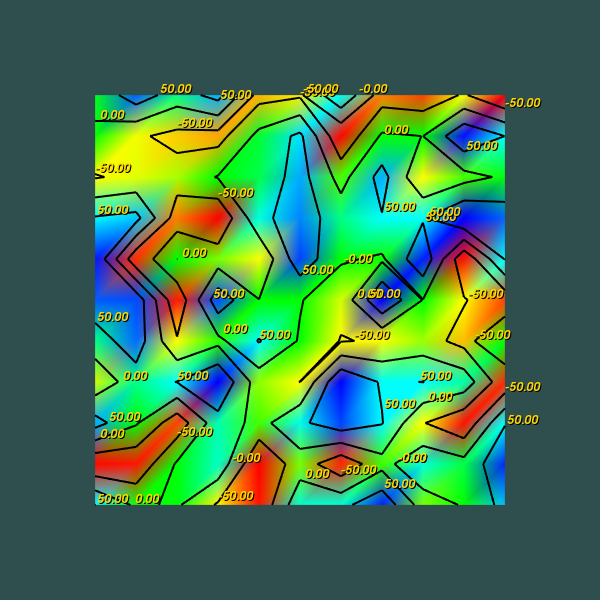LabelContours
vtk-examples/Cxx/Visualization/LabelContours
Description¶
This example labels isolines created by vtkContourFilter. After the isolines are generated, the resulting disconnected lines segments are gathered into polylines by vtkStripper. Then an appropriate position along each line is chosen to place the label for the contour. Two strategies for label placement are illustrated: a point at the midpoint of the line or a random point. vtkLabeledDataMapper places the labels for the contour lines.
The program can be run with an input XML polydata file (.vtp) or without arguments. If a file is specified then one, two or a range of contours can be specified. If run without a file name, the example generates a random scalar field on a plane.
Note
The labels are represented as vtkActor2D's. If they are generated for a 3D surface, the labels that should be hidden will still be displayed.
Question
If you have a question about this example, please use the VTK Discourse Forum
Code¶
LabelContours.cxx
#include <vtkActor.h>
#include <vtkActor2D.h>
#include <vtkCellArray.h>
#include <vtkContourFilter.h>
#include <vtkDataArray.h>
#include <vtkDoubleArray.h>
#include <vtkLabeledDataMapper.h>
#include <vtkLookupTable.h>
#include <vtkMinimalStandardRandomSequence.h>
#include <vtkNamedColors.h>
#include <vtkNew.h>
#include <vtkPlaneSource.h>
#include <vtkPointData.h>
#include <vtkPoints.h>
#include <vtkPolyDataMapper.h>
#include <vtkProperty.h>
#include <vtkRenderWindow.h>
#include <vtkRenderWindowInteractor.h>
#include <vtkRenderer.h>
#include <vtkSmartPointer.h>
#include <vtkStripper.h>
#include <vtkTextProperty.h>
#include <vtkXMLPolyDataReader.h>
#include <iomanip>
#include <iostream>
#ifdef VTK_CELL_ARRAY_V2
#include <vtkCellArrayIterator.h>
#endif // VTK_CELL_ARRAY_V2
int main(int argc, char* argv[])
{
vtkNew<vtkNamedColors> colors;
int pointThreshold = 10;
vtkSmartPointer<vtkPolyData> polyData;
vtkNew<vtkContourFilter> contours;
vtkNew<vtkMinimalStandardRandomSequence> randomSequence;
randomSequence->SetSeed(1);
// If a file is present, read it, otherwise generate some random
// scalars on a plane.
if (argc > 1)
{
vtkNew<vtkXMLPolyDataReader> reader;
reader->SetFileName(argv[1]);
reader->Update();
double range[2];
reader->GetOutput()->GetScalarRange(range);
polyData = reader->GetOutput();
std::cout << "range: " << range[0] << ", " << range[1] << std::endl;
contours->SetValue(0, (range[1] + range[0]) / 2.0);
contours->SetInputConnection(reader->GetOutputPort());
if (argc == 3)
{
contours->SetValue(0, atof(argv[2]));
}
else if (argc == 4)
{
contours->SetValue(0, atof(argv[2]));
contours->SetValue(1, atof(argv[3]));
}
else if (argc == 5)
{
contours->GenerateValues(atoi(argv[2]), atof(argv[3]), atof(argv[4]));
}
}
else
{
vtkNew<vtkPlaneSource> plane;
plane->SetXResolution(10);
plane->SetYResolution(10);
plane->Update();
vtkNew<vtkDoubleArray> randomScalars;
randomScalars->SetNumberOfComponents(1);
randomScalars->SetName("Isovalues");
for (int i = 0; i < plane->GetOutput()->GetNumberOfPoints(); i++)
{
randomScalars->InsertNextTuple1(
randomSequence->GetRangeValue(-100.0, 100.0));
randomSequence->Next();
}
plane->GetOutput()->GetPointData()->SetScalars(randomScalars);
polyData = plane->GetOutput();
contours->SetInputConnection(plane->GetOutputPort());
contours->GenerateValues(5, -100, 100);
pointThreshold = 0;
}
// Connect the segments of the contours into polylines.
vtkNew<vtkStripper> contourStripper;
contourStripper->SetInputConnection(contours->GetOutputPort());
contourStripper->Update();
auto numberOfContourLines = contourStripper->GetOutput()->GetNumberOfLines();
std::cout << "There are " << numberOfContourLines << " contour lines."
<< std::endl;
vtkPoints* points = contourStripper->GetOutput()->GetPoints();
vtkCellArray* cells = contourStripper->GetOutput()->GetLines();
vtkDataArray* scalars =
contourStripper->GetOutput()->GetPointData()->GetScalars();
// Create a polydata that contains point locations for the contour
// line labels.
vtkNew<vtkPolyData> labelPolyData;
vtkNew<vtkPoints> labelPoints;
vtkNew<vtkDoubleArray> labelScalars;
labelScalars->SetNumberOfComponents(1);
labelScalars->SetName("Isovalues");
#ifdef VTK_CELL_ARRAY_V2
// Newer versions of vtkCellArray prefer local iterators:
auto cellIter = vtk::TakeSmartPointer(cells->NewIterator());
for (cellIter->GoToFirstCell(); !cellIter->IsDoneWithTraversal();
cellIter->GoToNextCell())
{
vtkIdList* cell = cellIter->GetCurrentCell();
if (cell->GetNumberOfIds() < pointThreshold)
{
continue;
}
std::cout << "Line " << cellIter->GetCurrentCellId() << ": " << std::endl;
// Compute the point id to hold the label.
// Mid point or a random point.
// const vtkIdType samplePtIdx = cell->GetNumberOfIds() / 2;
const vtkIdType samplePtIdx = static_cast<vtkIdType>(
randomSequence->GetRangeValue(0, cell->GetNumberOfIds()));
randomSequence->Next();
auto midPointId = cell->GetId(samplePtIdx);
double midPoint[3];
points->GetPoint(midPointId, midPoint);
std::cout << "\tmidPoint is " << midPointId << " with coordinate "
<< "(" << std::fixed << std::setprecision(2) << midPoint[0]
<< ", " << midPoint[1] << ", " << midPoint[2] << ")"
<< " and value " << scalars->GetTuple1(midPointId) << std::endl;
labelPoints->InsertNextPoint(midPoint);
labelScalars->InsertNextTuple1(scalars->GetTuple1(midPointId));
}
#else // VTK_CELL_ARRAY_V2
// Older implementations of vtkCellArray use internal iterator APIs (not
// thread safe):
vtkIdType* indices;
vtkIdType numberOfPoints;
unsigned int lineCount = 0;
for (cells->InitTraversal(); cells->GetNextCell(numberOfPoints, indices);
lineCount++)
{
if (numberOfPoints < pointThreshold)
{
continue;
}
std::cout << "Line " << lineCount << ": " << std::endl;
// Compute the point id to hold the label.
// Mid point or a random point.
// auto midPointId = indices[numberOfPoints / 2];
// auto midPointId =
// indices[static_cast<vtkIdType>(vtkMath::Random(0, numberOfPoints))];
const vtkIdType samplePtIdx = static_cast<vtkIdType>(
randomSequence->GetRangeValue(0, cell->GetNumberOfIds()));
randomSequence->Next();
double midPoint[3];
points->GetPoint(midPointId, midPoint);
std::cout << "\tmidPoint is " << midPointId << " with coordinate "
<< "(" << std::fixed << std::setprecision(2) << midPoint[0]
<< ", " << midPoint[1] << ", " << midPoint[2] << ")"
<< " and value " << scalars->GetTuple1(midPointId) << std::endl;
labelPoints->InsertNextPoint(midPoint);
labelScalars->InsertNextTuple1(scalars->GetTuple1(midPointId));
}
#endif // VTK_CELL_ARRAY_V2
labelPolyData->SetPoints(labelPoints);
labelPolyData->GetPointData()->SetScalars(labelScalars);
vtkNew<vtkPolyDataMapper> contourMapper;
contourMapper->SetInputConnection(contourStripper->GetOutputPort());
contourMapper->ScalarVisibilityOff();
vtkNew<vtkActor> isolines;
isolines->SetMapper(contourMapper);
isolines->GetProperty()->SetColor(colors->GetColor3d("Black").GetData());
isolines->GetProperty()->SetLineWidth(2);
vtkNew<vtkLookupTable> surfaceLUT;
surfaceLUT->SetRange(polyData->GetPointData()->GetScalars()->GetRange());
surfaceLUT->Build();
vtkNew<vtkPolyDataMapper> surfaceMapper;
surfaceMapper->SetInputData(polyData);
surfaceMapper->ScalarVisibilityOn();
surfaceMapper->SetScalarRange(
polyData->GetPointData()->GetScalars()->GetRange());
surfaceMapper->SetLookupTable(surfaceLUT);
vtkNew<vtkActor> surface;
surface->SetMapper(surfaceMapper);
// The labeled data mapper will place labels at the points.
vtkNew<vtkLabeledDataMapper> labelMapper;
labelMapper->SetFieldDataName("Isovalues");
labelMapper->SetInputData(labelPolyData);
labelMapper->SetLabelModeToLabelScalars();
labelMapper->SetLabelFormat("%6.2f");
labelMapper->GetLabelTextProperty()->SetColor(
colors->GetColor3d("Gold").GetData());
vtkNew<vtkActor2D> isolabels;
isolabels->SetMapper(labelMapper);
// Create a renderer and render window.
vtkNew<vtkRenderer> renderer;
vtkNew<vtkRenderWindow> renderWindow;
renderWindow->AddRenderer(renderer);
renderWindow->SetSize(600, 600);
renderWindow->SetWindowName("LabelContours");
// Create an interactor
vtkNew<vtkRenderWindowInteractor> renderWindowInteractor;
renderWindowInteractor->SetRenderWindow(renderWindow);
// Add the actors to the scene
renderer->AddActor(surface);
renderer->AddActor(isolines);
renderer->AddActor(isolabels);
renderer->SetBackground(colors->GetColor3d("DarkSlateGray").GetData());
// Render the scene (lights and cameras are created automatically).
renderWindow->Render();
renderWindowInteractor->Start();
return EXIT_SUCCESS;
}
CMakeLists.txt¶
cmake_minimum_required(VERSION 3.12 FATAL_ERROR)
project(LabelContours)
find_package(VTK COMPONENTS
CommonColor
CommonCore
CommonDataModel
FiltersCore
FiltersSources
IOXML
InteractionStyle
RenderingContextOpenGL2
RenderingCore
RenderingFreeType
RenderingGL2PSOpenGL2
RenderingLabel
RenderingOpenGL2
)
if (NOT VTK_FOUND)
message(FATAL_ERROR "LabelContours: Unable to find the VTK build folder.")
endif()
# Prevent a "command line is too long" failure in Windows.
set(CMAKE_NINJA_FORCE_RESPONSE_FILE "ON" CACHE BOOL "Force Ninja to use response files.")
add_executable(LabelContours MACOSX_BUNDLE LabelContours.cxx )
target_link_libraries(LabelContours PRIVATE ${VTK_LIBRARIES}
)
# vtk_module_autoinit is needed
vtk_module_autoinit(
TARGETS LabelContours
MODULES ${VTK_LIBRARIES}
)
Download and Build LabelContours¶
Click here to download LabelContours and its CMakeLists.txt file. Once the tarball LabelContours.tar has been downloaded and extracted,
cd LabelContours/build
If VTK is installed:
cmake ..
If VTK is not installed but compiled on your system, you will need to specify the path to your VTK build:
cmake -DVTK_DIR:PATH=/home/me/vtk_build ..
Build the project:
make
and run it:
./LabelContours
WINDOWS USERS
Be sure to add the VTK bin directory to your path. This will resolve the VTK dll's at run time.
